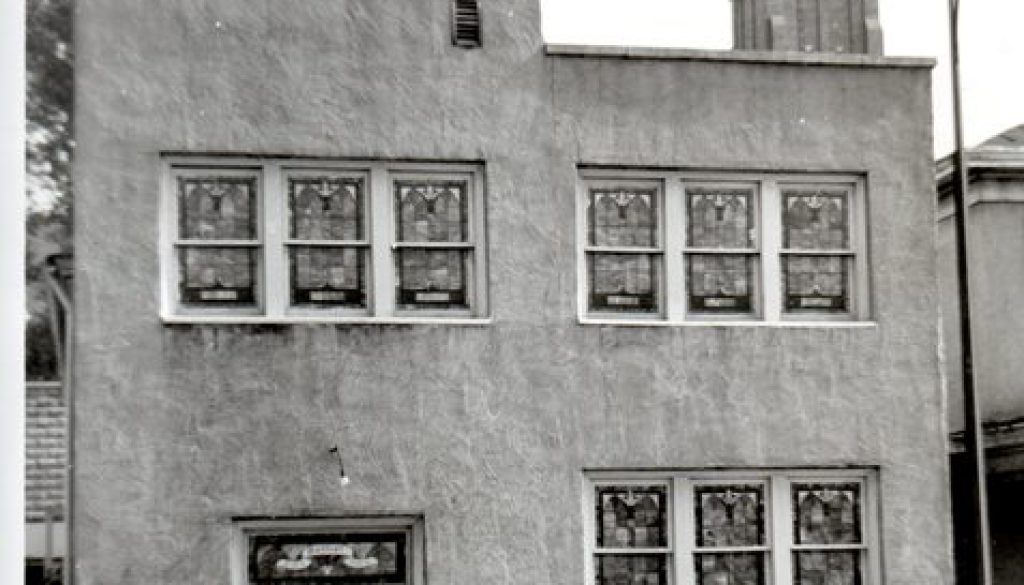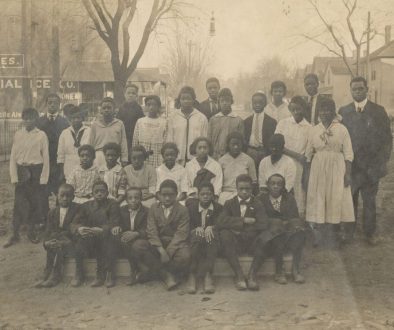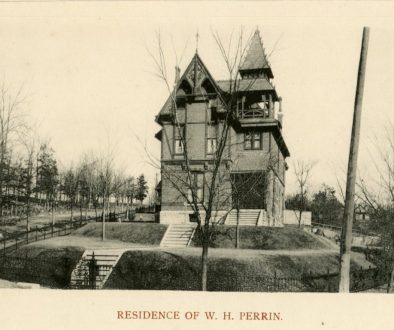The Bethel African Methodist Episcopal Church
An African American Historic Site by Mary Anthrop
“He stood before his audience, like a statue of Jefferson done in bronze – calm, majestic, impressive – the true type of a self-made man, rising superior to the circumstances which chained him down, and achieving greatness in the face of unreasoning prejudice and unscrupulous wrong.”
April 19, 1867 – Lafayette Daily Courier
The Baptist Church in Lafayette could not hold all the people in Lafayette, Indiana who wanted to hear Frederick Douglass, the distinguished civil rights leader of the 19th century. For nearly two and a half hours he spoke on the future of racial justice and political equality to an attentive and appreciative crowd. While the Lafayette Daily Courier devoted most of their reporting to the contents of the speech and community reaction, the last sentence of the newspaper column noted that the net proceeds of the lecture resulted in over $200 for the African M.E. Church.
As southern freedmen increased the African church membership after the Civil War, the small Lafayette African American population purchased property from the Lutheran community on Ferry Street. The African congregation used lectures, fairs and public donations to pay for their new church.
Today the Bethel African Methodist Episcopal Church on Ferry Street stands as one of the few physical reminders of the historical contributions of African Americans to the city of Lafayette. The early history of Lafayette’s A.M.E. congregation confirms the significance of this historic site.
In the decades before and after the Civil War, Tippecanoe County’s African American population was very small. According to an 1846 city census, only 180 of Lafayette’s 4,146 residents claimed to be of African descent. Tippecanoe County’s African American population would never number more than 200 people until the end of the 19th century.
Most African Americans in Tippecanoe County selected to live in homes scattered about Lafayette rather than in the countryside. This preference for an urban area was a typical choice of free blacks in Indiana in the mid-nineteenth century. Free blacks found young and developing towns, like Lafayette, in need of workers. In Lafayette African Americans labored as boatmen, bakers, cooks and whitewashers. There was also an African American cooper, blacksmith, groom, fisherman, butcher and schoolteacher. In the 1840s and 1850s free blacks monopolized the barber business. 16 African-Americans listed barber as their occupation in the 1850 federal census. Several men operated their own shops as noted by their ads in the Lafayette newspapers. One blacksmith, Jacob Gwinn of Wabash Township, acquired a property wealth of $800 by 1850.
The Bethel A.M.E. Church was likely at the center of the cultural, educational and political activities of this small and enterprising community. Denied opportunities in the white world, the A.M.E. Church was a vehicle for the expression of African-American culture.
The influence of the A.M.E. Church in Lafayette emerged as early as 1843. Participants in a local Colored People’s Convention in April of 1843 had strong A.M.E. affiliations. At this convention local men passed a resolution to encourage the organization of a common school system supported by the united resources of the Indiana African American community. The chairman of the convention was Daniel Brown, a whitewasher and sexton at St. John’s Episcopal Church. Samuel B. Webster, a barbershop owner and schoolteacher, was the assistant secretary. Brown’s name appeared as a trustee of the A.M.E. Church on several property transactions and Webster was President of the A.M.E. Sabbath School in 1844.
By July of 1846 an A.M.E. congregation formally organized. Trustees Daniel Brown, David Mitchell, Charles Sprangler, John Homes, Hazel Cummins, Robert Burt and Jacob Skipworth purchased for $85 a half lot on Cincinnati Street between 10th and 11th Streets. In December of 1846 the congregation announced in the Lafayette Daily Courier that they wanted to build a house of worship on the purchased lot by spring. The congregation maintained a church and sometimes conducted a school at this site until they sold the property in the summer of 1866 for $500.
The A.M.E. congregation, like other denominations in Lafayette, organized social festivals and suppers. Such activities fostered the congregation’s cultural identity and ensured its visibility in the larger community. Newspaper notices extended invitations to the white community. With the admission at only 10 cents the fairs appeared to be popular and well attended. One fair in 1851 collected over $75 dollars for the church.
The African American community also chose their churches as sites for political expression. When the Union army needed recruits for the 28th Indiana Colored Troops, an officer addressed the Lafayette free black community at the African Church on Cincinnati Street. At that meeting Dr. Luther Jewett, a locally recognized abolitionist, also encouraged Union enlistment. Lafayette’s free black population enthusiastically responded to his inducements and during the course of the Civil War several local African Americans citizens gave their lives to end slavery in the United States.
One of the largest celebrations in Indiana for the ratification of the 15th Amendment began at the steps of the A.M.E. Church on Ferry Street. On April 23, 1870, a local 28th U.S.C.T. Indiana veteran, Thomas Brown, led a parade of dignitaries and supporters through the streets of Lafayette. Governor Baker of Indiana, and Rev. J.M. Williams of Indianapolis, a former slave, spoke on the recent accomplishments of African Americans. A supper and festival at the A.M.E. Church concluded the activities.
Probably the most enduring contribution of the A.M.E. Church was its educational efforts. Denied admittance to public schools and access to common school funds, the A.M.E. Church used its limited resources to educate both adults and children in their congregation. An A.M.E. Church sponsored school operated as early as 1850. Census records of 1850 indicate that over one-half of the African American children in Lafayette attended school in that year. A letter in the Lafayette Daily Courier in April of 1850 praised the performance of an African American school exhibition. The writer credited Mr. Johnson, the minister-in-charge, with teaching the children and removing the church from debt. Census records and city directories also list African American schoolteachers into the early 1860s.
At the end of the Civil War in 1865 former slaves, many who were illiterate, migrated to Indiana and other northern states. Adults, as well as children, desired educational opportunities. The Indiana legislature, however, did not mandate that school trustees organize schools for African American children until 1869. Without public support church schools struggled to provide academic instruction during those difficult years of social and political transition.
In the spring of 1866 the Lafayette A.M.E. congregation considered digging a basement under their Cincinnati Street Church to construct a Sabbath and day school. In the summer the congregation, however, purchased the church, the parsonage and the school buildings of the St. James Lutheran Church on Ferry Street. Although this purchase incurred a large debt, the congregation committed to providing educational opportunities. For the next few years the congregation solicited support from other area churches and sponsored festivals and lectures to reduce their debt.
The Lafayette School Trustees approved the opening of a public school at the A.M. E. Church in September of 1869. Forty-nine students enrolled the first year. A night school was also opened to accommodate day workers. The school continued at the A.M.E. site until the 1880s when the school moved to the North-End of Lafayette.
Throughout the 19th century Lafayette residents extended their help to the congregation. Rev. Samuel Johnson, the founder of St. John’s Episcopal Church, considered A.M.E. trustee Daniel Brown and his wife as confidants. According to Church lore he often sought their friendship when troubled. In the winter of 1845-’46 Johnson sheltered members of the black community when a pro-slavery mob attempted to burn the homes of the free black population of Lafayette. Quakers in the southern part of the county in 1866 donated $50 for the purchase of the Ferry Street properties. In 1867 Martin L. Pierce, former sheriff, banker and a recognized abolitionist before the Civil War, hosted Frederick Douglass for a lecture at the Baptist Church.
As an historical landmark, the Bethel A.M.E. Church is important to anyone interested in understanding and appreciating Lafayette’s history. Hopefully members of the greater Lafayette community will continue to see the benefits of preserving the Bethel A.M.E. Church for future generations. Research on the A.M.E. Church was conducted under “Sacred Sites and Schools” a Historic Preservation Education Grant awarded to the Lafayette Area Catholic Schools in 1998. Historic Landmarks Foundation of Indiana and the Indiana Humanities Council sponsored Historic Preservation Education Grants.




